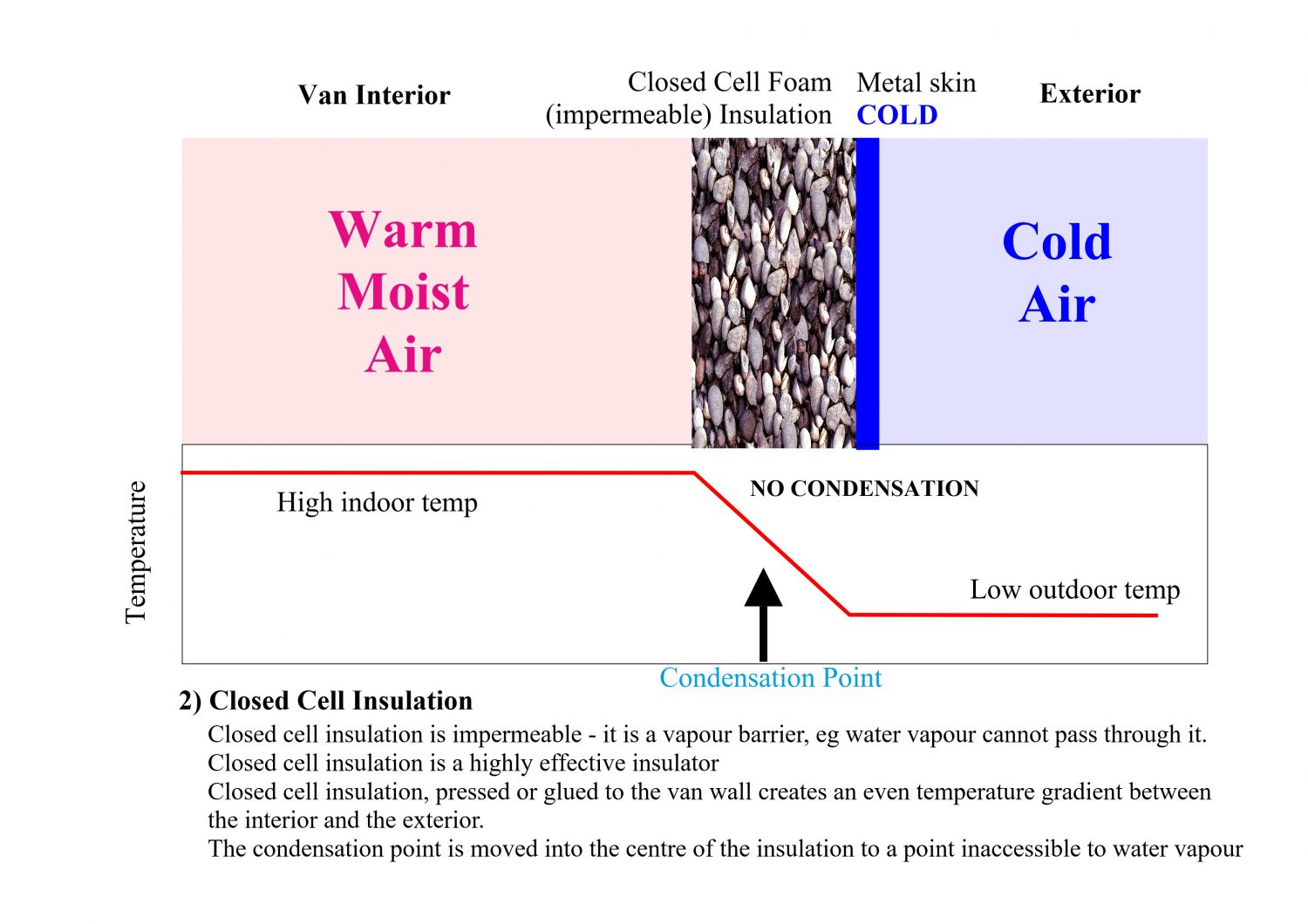Campervan Insulation and Condensation explained
There are a lot of myths about campervan insulation. Terms crop up like: vapour-barrier, air-gap, and shiny bubble-wrap. People often like to take the techniques they use in house building (cavity walls, warm/cold roof systems). However, a campervan has a very different structure to a domestic house.
To begin with, the main myth is that the purpose of insulating a campervan is to keep you warm inside. It will do that, but as anyone who has slept in an uninsulated van will atest, its main purpose is to prevent condensation.
Condensation drips off the ceiling of the van onto your head and soaks your sleeping bag. It runs down the walls behind the panels and rusts the bodywork.
What Condensation?
We breath in air, we breath out air with added heat and moisture. This causes two problems:
- Warm air holds more moisture
- Warm air releases the moisture as condensation
When warm moist air hits a cold surface, the air cools rapidly and releases its water vapour to form condensation. For a given moisture content (internal:external) there will be a specific temperature, below which the moiture will be released. This is known as the Condensation Point.

The critical thing to look at is the lower part of the diagram showing the temperature. The slope of the change from high temperature to low temperature is called the Temperature Gradient. In the example shown, the gradient is vertical.
The condensation will run down the van panel and collect, potentially causing rust.
Stopping condensation
There are several ways in which you can stop the condensation.
- Ventilate the interior with fans and open windows to remove the warm moist air and replace it with air as cold as the outside – so there is no temperature gradient.
- Run a dehumidifier all the time to take out the moisture.
- Use insulation to move the condensation point away from the van wall.
Insulation is a very effective way of solving the problem, and keeping the van warm.
Effective Insulation
Remember – the main purpose is to stop condensation and secondly to keep you warm.
There are a lot of insulation materials.
What to look for in an insulation material for preventing condensation:-
1) Low thermal conductivity
2) High R-Value
3) Impermeable to moisture
Also considering the application in a vehicle it should be:-
Lightweight
Stable (does not breakdown or settle with vibration)
The most effective kinds of insulation commonly available to meet these criteria are closed cell foam products. There are a various types, some are better than others in different situations.
This is how a closed cell foam insulation can prevent condensation:-

In this example, you can see that there is a ‘sloping’ temperature gradient, such that the condensation point is moved away from the wall and located within the insulation.
The closed cell structure is effective at stopping air movement through the insulation.
The impermeable nature of the closed cell foam material stops the moisture from reaching the condensation point.
Suitable closed-cell foam products – these are high performance insulators.
Celotex
Kingspan
Jablite
Thermoliner or similar (self-adhesive and flexible)
Porous Insulation
Many people use fibre/wool/rockwool/recycled plastic as insulation.
Whilst it is used as an insulation in buildings, it is not a good method for insulating metal sided vans. The moist air will still be able to permeate the insulation and condensate on the metal skin. From there it can run down the inside. Many people have reported a soggy, rusty mess of waterlogged rockwool that is rotting out the bottom of the panel, or below. In some ways worse than not having insulation at all.

Vapour Barrier
Using a vapour barrier can stop the moist air from permeating the insulation. This may be sufficient, but you can get the situation where moisture already trapped in the void can cause condensation. Usually much less than the previous example, but sometimes not.

Air Gap
Whether you use fibre type permeable insulation or have an air-gap, the risk of condensation is similar (see above) – any moisture in that void will condensate and cause problems.
Whilst air-gaps are important in certain kinds of domestic roofing systems, they are not appropriate in metal boxes.
Conclusions
Remember – the main reason for insulating a campervan is to stop condensation.
Impermeable insulation will be the most effective to prevent moist air from reaching the metal skin of the van.
Closed-cell foam – High insulation performance, impermeable to moist air
Fibre – Lower insulation performance, allows moist air to reach the metal skin.
nb: Bubble-wrap and foil bubble-wrap are very poor insulators, but may work as a vapour barrier.


